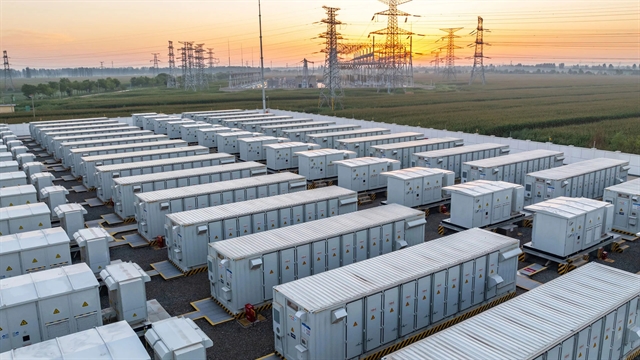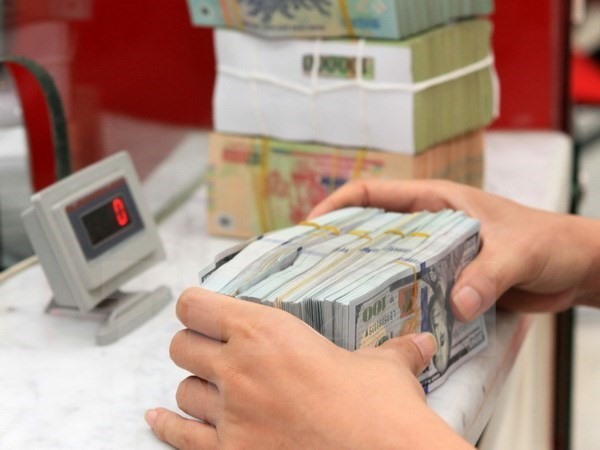 Business Beat
Business Beat

On December 11 the State Bank of Việt Nam reduced the value of the đồng against the US dollar by VNĐ9 from the previous day to VNĐ22,775 (US$1).
 |
| In the year until December 7 the greenback appreciated by around 2.4 per cent against the Vietnamese currency, which however was lower than the 3 per cent forecast before. — VNA/VNS Photo |
On December 11 the State Bank of Việt Nam reduced the value of the đồng against the US dollar by VNĐ9 from the previous day to VNĐ22,775 (US$1).
The selling price of the greenback at the central bank’s transaction offices was also adjusted to VNĐ23,408 though the buying price was kept unchanged at VNĐ22,700.
At commercial banks, the price of the greenback did not see strong fluctuations. Vietcombank still kept its selling and buying prices at VNĐ23,265 and 23,355.
Similarly, BIDV kept its rates unchanged at VNĐ23,260 and 23,350.
Market observers said the central bank has been adjusting its daily reference rate for the đồng against the dollar constantly since early December though the adjustments have been minor.
Why does the central bank continue to devalue the Vietnamese currency when globally the dollar is weakening after the US and China agreed to halt their trade war for 90 days?
For instance, in the Asian dollar market, the dollar index, which tracks the greenback against six major currencies, was down 0.06 per cent at 97.14.
Analysts have advanced various reasons to explain the central bank’s move to devalue the đồng in recent times.
In the year until December 7 the greenback appreciated by around 2.4 per cent against the Vietnamese currency, which however was lower than the 3 per cent forecast before.
The central bank’s decision to adjust the exchange rate was partly impelled by signs of illegal arbitrage in recent times to profit from its efforts to keep the rates steady.
This involved some enterprises who earned dollars from exports selling the greenback in the open market at high rates and then buying dollars from banks at lower prices.
Another reason was that it wanted to support export enterprises especially since the Chinese yuan has fallen sharply against the dollar.
Since the middle of last year the đồng has been under pressure as the dollar strengthened relentlessly against global currencies and the yuan correspondingly weakened.
However, the đồng only slightly weakened against the dollar, meaning the Vietnamese currency has appreciated sharply against the yuan, causing China’s products to flood Việt Nam as that country’s trade war against the US plays out.
A banking industry insider also pointed out another reason for the central bank to continuously appreciate the value of the dollar.
The central bank wanted to wait in front for the US Reserve Federal’s dollar interest rate hikes in coming times, which, he said, often caused impacts on the VNĐ/USD exchange rate on both official and unofficial markets.
Analysts said that the market’s dollar demand would likely increase significantly because the imports would be up to meet consumers’ demand in the peak shopping season, thus also putting pressure on the exchange rate.
The trade deficit with China is expected to reach US$500-600 million by the end of 2019, they said.
But they expect the foreign exchange market to remain under control because the central bank has abundant foreign reserves and is ready to intervene in the market whenever necessary.
Transparent policies benefit power sector
The Phả Lại Thermal Power Joint Stock Company (PPC) expects to achieve after-tax profit of VNĐ1trillion (US$43 million) in 2018, representing a year-on-year increase of 50 per cent.
In the first quarter, its after-tax profit was estimated at VNĐ735.63 billion ($31.6 million), up by 4.5 per cent compared with the figure recorded the previous year.
Hydroelectricity companies have also tried to keep up with thermal power companies with some rather impressive business results.
Of them, Thác Mơ Hydro Power Joint Stock Company (TMP) was one of the first to achieve the yearly targets.
In the first three quarters of last year TMP reported revenues of VNĐ626.8 billion, up 16 per cent from the same period in 2017, and after-tax profit of VNĐ320 billion 50 per cent higher than the full-year target.
The Thác Bà Hydro Power Joint Stock Company too reported a profit that was 15.7 per cent above the full-year target in just the first nine months.
Though not directly involved in power generation, the Power Engineering Consulting Joint Stock Company No.2 reported after-tax profit of VNĐ159.8 billion, up 44 per cent year-on-year.
What has caused power companies to achieve such impressive results?
Analysts said the Government’s determination to develop a competitive power generation market was the most important reason.
The development of such a market was a long-term plan mandated by the 2004 Electricity Law.
The details of the plan were specified in the Prime Minister’s Decision 63/QĐ-TTg in 2013, which laid out the conditions and structure for the new market and a development road map for the power market.
Based on this, the marketplace was to be developed in three distinct parts: a competitive electricity generation market, a competitive wholesale power market and a retail market.
A competitive power generation market had already been in operation since July 2012. Three years later it had 59 power plants with a total capacity of 14,796MW, accounting for 41.63 per cent of the country’s total capacity.
ERA requires all power plants directly participating in the electricity generation market to guarantee they have the required infrastructure, a license to supply power with the contract prices still valid.
The competitive power wholesale market began trial operation last year and is expected to begin official functioning from 2019.
The electricity retail market is set to make a start in 2022.
Experts said the competitive power generation market enhances transparency in raising power sources, especially from power plants outside the Electricity of Việt Nam (EVN).
An official from the Ministry of Industry and Trade concurred with the view, pointing out the increased transparency has helped create a system that investors can trust to integrate their power plants into the national electricity grid.
Putting the competitive power wholesale market into operation would be a big step forward in the liberalisation of the country’s power sector and help increase competition and improve enterprises’ production and trading efficiency, he added. — VNS




